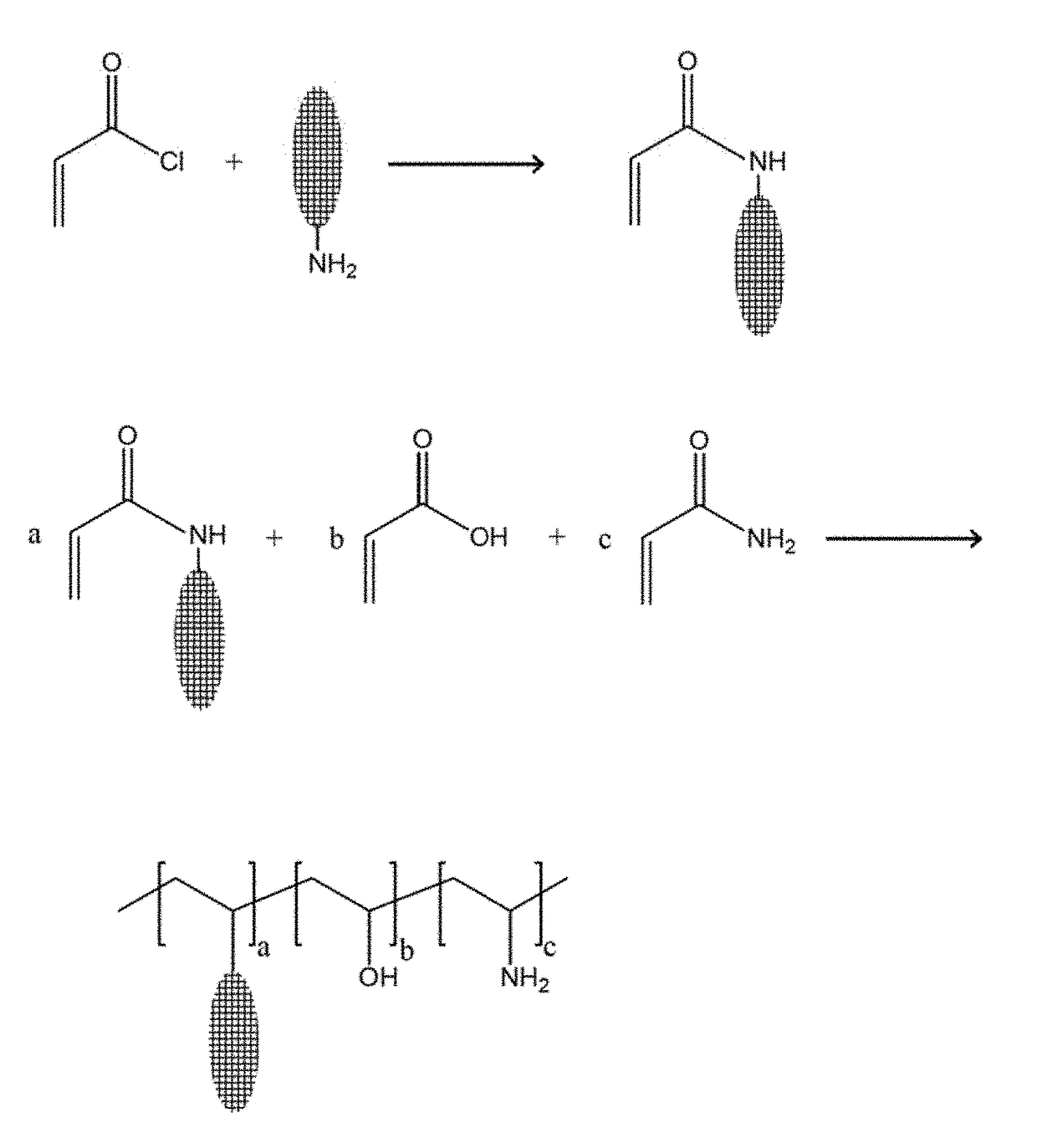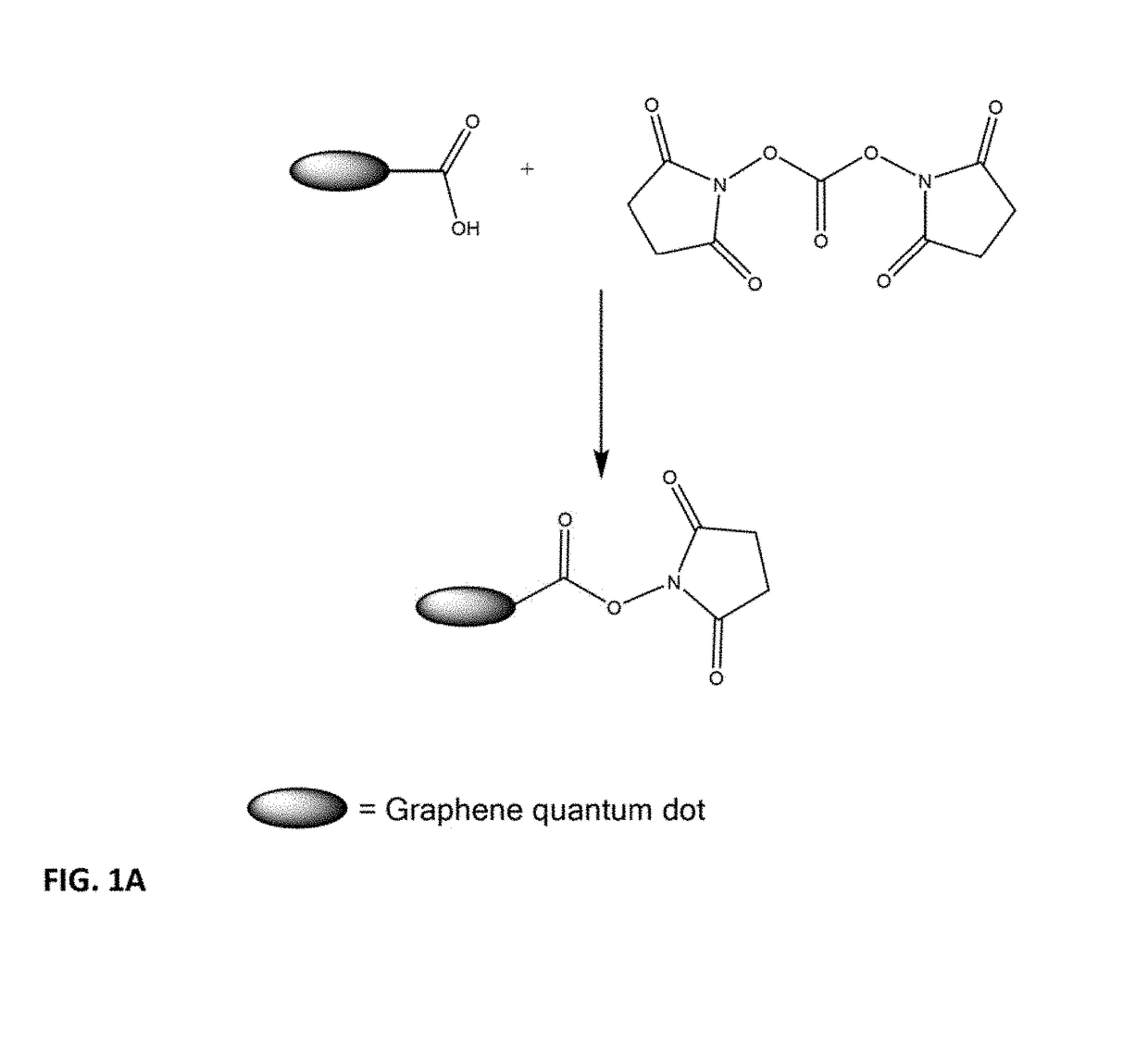Fluorescent water treatment compounds and method of use
a technology of fluorescent water treatment and fluorescence, which is applied in the direction of water treatment compounds, water/sewage treatment by substance addition, and waste water treatment from quaries, etc. it can solve the problems of difficult to find an inert (chemically unreactive) fluorophore that overcomes, and the reaction of fluorophores to water soluble chemicals such as treatment compounds used to treat industrial water sources, and achieves good dispersibility and compatibility of gqd in industrial
- Summary
- Abstract
- Description
- Claims
- Application Information
AI Technical Summary
Benefits of technology
Problems solved by technology
Method used
Image
Examples
example 1
[0109]
[0110]The compound shown above was synthesized according to techniques set forth in B. Neises, W. Steglich, Angew. Chem. Int. Ed., 1978, 17, 522-524. To a mixture of carboxylic acid-functional Graphene Quantum Dot (GQD) (25 mg) and N,N-dimethyl-4-aminopyridine (1.3 mg, 0.01 mmol) in 0.5 mL of dimethyl formamide chilled in an ice-water bath, was added dicyclohexyl carbodiimide (9.06 mg, 0.04 mmol) in one portion. The mixture was stirred for 10 min, and then the ice bath was removed. The primary amino precursor compound corresponding to the structure above, 2-(2-heptadecyl)1H-imidazol-1-yl)ethan-1-amine:
was added (28 mg, 0.04 mmol), and the mixture stirred at ambient temperature for 2 h. Then 2.5 mL deionized (DI) water was added to the mixture; then the mixture was centrifuged and washed with 1 mL of DI water twice. The solid particles obtained from the centrifugation were resuspended in 3 mL DI water with 1 drop of acetic acid. The product is referred to as GQD-1.
[0111]Then 40...
example 2
[0114]Triclosan, 5-chloro-2-(2,4-dichlorophenoxy)phenol, is functionalized with GQD according to B. Neises, W. Steglich, Angew. Chem. Int. Ed., 1978, 17, 522-524 using the following technique. To a mixture of carboxylic acid-functional Graphene Quantum Dot (GQD) (25 mg) and N,N-dimethyl-4-aminopyridine (1.3 mg, 0.01 mmol) in 0.5 mL of dimethyl formamide chilled in an ice-water bath, is added dicyclohexyl carbodiimide (9.06 mg, 0.04 mmol) in one portion. The mixture is stirred for 10 min, and then the ice bath is removed. Triclosan,
is added (11.6 mg, 0.04 mmol), and the mixture is stirred at ambient temperature for 2 h. Then 2.5 mL deionized (DI) water is added to the mixture; then the mixture is centrifuged and washed with 1 mL of DI water twice. The solid particles obtained from the centrifugation are resuspended in 3 mL DI water with 1 drop of acetic acid. The product is referred to as GQD-2.
[0115]To enable direct measurement of the concentration of triclosan in the formulation du...
example 3
[0117]A tall oil (C16-C18) adduct of diethylenetriamine imidazoline (TOFA-DETA) was reacted with a carboxylic acid-functional GQD using the technique of Example 1 to form “TOFA-DETA-GQD”. TOFA-DETA is a material conventionally employed to prevent corrosion in metal pipes carrying aqueous industrial processing streams, especially those bearing petroleum / brine mixtures produced by petroleum product extraction from subterranean reservoirs.
[0118]Corrosion bubble cell tests were performed using the general procedure set forth in Andreev, N. et al., J. Corros. Scale Inhib. 2013, 2(1), 17-19. Conditions used were C1018 carbon steel electrode; 80° C.; CO2 saturated aqueous dispersion including 3 wt % NaCl and 20 wt % of a hydrocarbon mixture (75 wt % LVT 200 hydrotreated light distillate, 25 wt % xylene); continuous CO2 sparge; and atmospheric pressure. The brine / hydrocarbon mixture was first allowed to contact the C1018 carbon steel electrode for about 3 hours before adding the corrosion i...
PUM
| Property | Measurement | Unit |
|---|---|---|
| Fraction | aaaaa | aaaaa |
| Fraction | aaaaa | aaaaa |
| Percent by mass | aaaaa | aaaaa |
Abstract
Description
Claims
Application Information
 Login to View More
Login to View More - R&D
- Intellectual Property
- Life Sciences
- Materials
- Tech Scout
- Unparalleled Data Quality
- Higher Quality Content
- 60% Fewer Hallucinations
Browse by: Latest US Patents, China's latest patents, Technical Efficacy Thesaurus, Application Domain, Technology Topic, Popular Technical Reports.
© 2025 PatSnap. All rights reserved.Legal|Privacy policy|Modern Slavery Act Transparency Statement|Sitemap|About US| Contact US: help@patsnap.com



